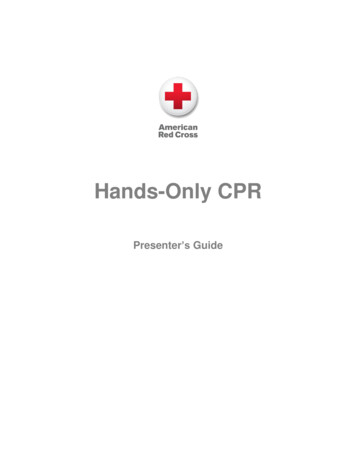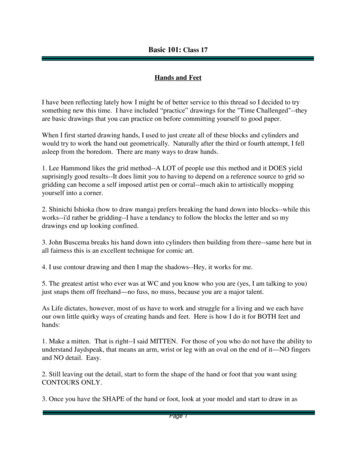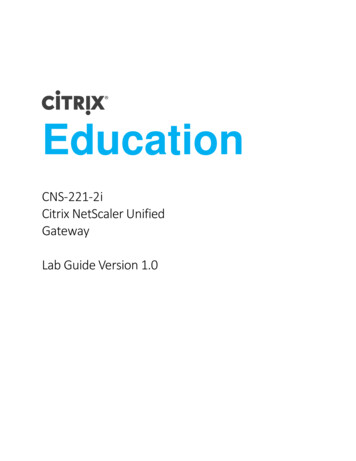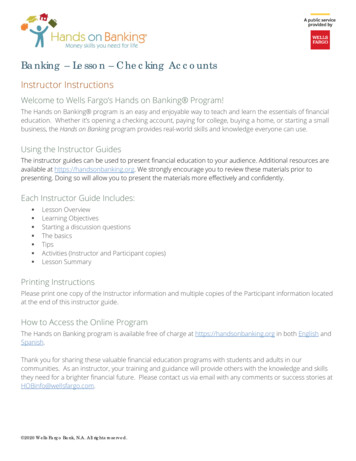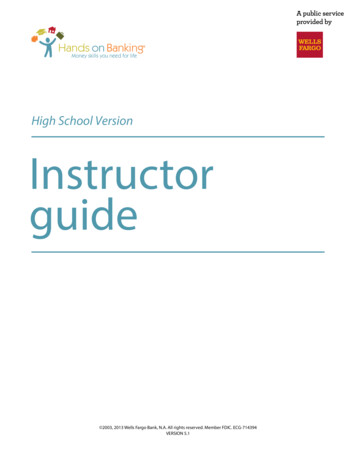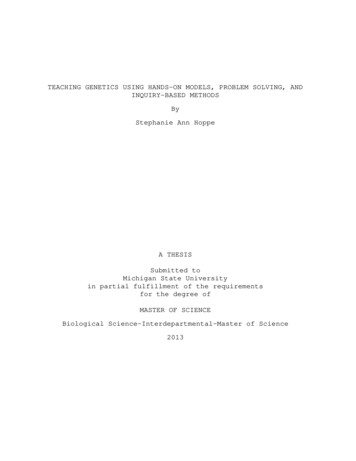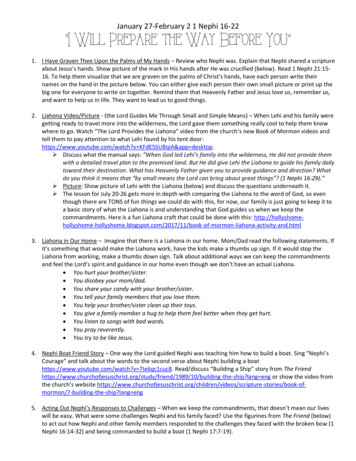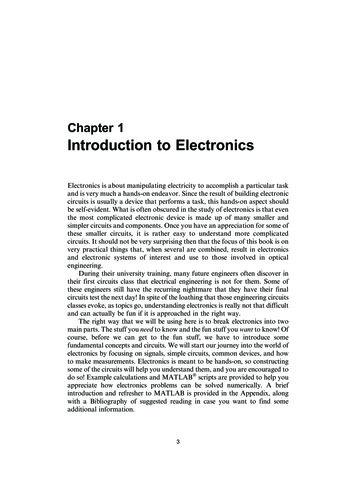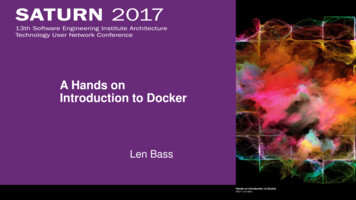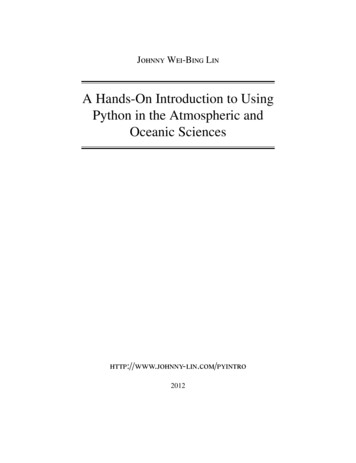
Transcription
Johnny Wei-Bing LinA Hands-On Introduction to UsingPython in the Atmospheric andOceanic Scienceshttp://www.johnny-lin.com/pyintro2012
c 2012 Johnny Wei-Bing Lin.Some rights reserved. Printed version: ISBN 978-1-300-07616-2. PDF versions: No ISBNs are assigned.This work is licensed under the Creative Commons Attribution-Noncommercial-Share Alike 3.0 United States License (CC BY-NC-SA). To view acopy of this license, visit s or send a letter to Creative Commons, 171 Second Street, Suite 300, SanFrancisco, California, 94105, USA.Who would not want to pay money for this book?: if you do not needa black-and-white paper copy of the book, a color PDF copy with functionalhyperlinks, have limited funds, or are interested in such a small portion ofthe book that it makes no sense to buy the whole thing. The book’s web site(http://www.johnny-lin.com/pyintro) has available, for free, PDFs of everychapter as separate files.Who would want to pay money for this book?: if you want a blackand-white paper copy of the book, a color PDF copy with functional hyperlinks, or you want to help support the author financially. You can buya black-and-white paper copy of the book at http://www.johnny-lin.com/pyintro/buypaper.shtml and a hyperlink-enabled color PDF copy of the bookat http://www.johnny-lin.com/pyintro/buypdf.shtml.A special appeal to instructors: Instruction at for-profit institutions, asa commercial use, is not covered under the terms of the CC BY-NC-SA, andso instructors at those institutions should not make copies of the book forstudents beyond copying permitted under Fair Use. Instruction at not-forprofit institutions is not a commercial use, so instructors may legally makecopies of this book for the students in their classes, under the terms of the CCBY-NC-SA, so long as no profit is made through the copy and sale (or FairUse is not exceeded). However, most instruction at not-for-profit institutionsstill involves payment of tuition: lots of people are getting paid for theircontributions. Please consider also paying the author of this book somethingfor his contribution.Regardless of whether or not you paid money for your copy of the book,you are free to use any and all parts of the book under the terms of the CCBY-NC-SA.
Chapter 7An Introduction to OOP UsingPython: Part I—Basic Principlesand Syntax7.1What is object-oriented programmingObject-oriented programming (OOP), deservedly or not, has something of areputation as an obtuse and mysterious way of programming. You may haveheard of it, and even heard that it is a powerful way of writing programs, butyou probably haven’t heard a clear and concise description of how it worksto help you write better AOS programs. Unfortunately, I also cannot giveyou a clear and concise description of how OOP works to help you program.The problem is not that I cannot describe to you what an object is or giveyou a definition of OOP, but rather that any description of the mechanics anduse of OOP does not really capture how OOP makes your life easier as ascientist programmer. It’s like thinking that a description of oil pigments andpoplar surfaces will somehow enable you to “get” how the Mona Lisa works.For both OOP and art, you can’t describe the forest in terms of the trees.Really, the only way I know of to convey how OOP enables atmosphericand oceanic scientists to do better science using a computer is to give youmany examples of its use. So, in this chapter, I’ll do just that. After a briefdescription of the mechanics of OOP, we’ll look at some simple examplesand work through some more complex examples, including examples fromthe atmospheric and oceanic sciences. Through these examples, I hope todescribe both how to write object-oriented programs as well as why objectoriented programs work the way they do.97
7.1. WHAT IS OBJECT-ORIENTED PROGRAMMING7.1.1Proceduralprogramshave data andfunctions asseparateentities.Real worldobjects havestates andbehaviors.One good way of describing something new is to compare it with somethingold. Most atmospheric and oceanic scientists have had experience with procedural programming, so we’ll start there. Procedural programs look at theworld in terms of two entities, “data” and “functions.” In a procedural context, the two entities are separate from each other. A function takes data asinput and returns data as output. Additionally, there’s nothing customizableabout a function with respect to data. As a result, there are no barriers tousing a function on various types of data, even inappropriately.In the real world, however, we don’t think of things or objects as havingthese two features (data and functions) as separate entities. That is, realworld objects are not (usually) merely data nor merely functions. Real worldobjects instead have both “state” and “behaviors.” For instance, people havestate (tall, short, etc.) and behavior (playing basketball, running, etc.), oftenboth at the same time, and, of course, in the same person.The aim of object-oriented programming is to imitate this in terms ofsoftware, so that “objects” in software have two entities attached to them,states and behavior. This makes the conceptual leap from real-world to programs (hopefully) less of a leap and more of a step. As a result, we can moreeasily implement ideas into instructions a computer can understand.7.1.2Objects aremade up ofattributes andmethods.Objectinstances arespecificrealizations ofa class.Procedural vs. object-oriented programmingThe nuts and bolts of objectsWhat do objects consist of? An object in programming is an entity or “variable” that has two entities attached to it: data and things that act on that data.The data are called attributes of the object, and the functions attached to theobject that can act on the data are called methods of the object. Importantly,you design these methods to act on the attributes; they aren’t random functions someone has attached to the object. In contrast, in procedural programming, variables have only one set of data, the value of the variable, with nofunctions attached to the variable.How are objects defined? In the real world, objects are usually examples or specific realizations of some class or type. For instance, individualpeople are specific realizations of the class of human beings. The specific realizations, or instances, differ from one another in details but have the samepattern. For people, we all have the same general shape, organ structure, etc.In OOP, the specific realizations are called object instances, while the common pattern is called a class. In Python, this common pattern or template isdefined by the class statement.98
7.2. EXAMPLE OF HOW OBJECTS WORK: STRINGSSo, in summary, objects are made up of attributes and methods, the structure of a common pattern for a set of objects is called its class, and specificrealizations of that pattern are called “instances of that class.”Recall that all the Python “variables” we introduced earlier are actuallyobjects. (In fact, basically everything in Python is an object.) Let’s look at anumber of different Python objects to illustrate how objects work.7.2Example of how objects work: StringsPython strings (like nearly everything else in Python) are objects. Thus, builtinto Python, there (implicitly) is a class definition of the string class, and every time you create a string, you are using that definition as your template.That template defines both attributes and methods for all string objects, sowhatever string you’ve created, you have that set of data and functions attached to your string which you can use. Let’s look at a specific case:Example 45 (Viewing attributes and methods attached to strings andtrying out a few methods):In the Python interpreter, type in:a "hello"Now type: dir(a). What do you see? Type a.title() and a.upper()and see what you get.Solution and discussion: The dir(a) command gives a list of (nearly)all the attributes and methods attached to the object a, which is the string"hello". Note that there is more data attached to the object than just theword “hello”, e.g., the attributes a. doc and a. class also show up inthe dir listing.Methods can act on the data in the object. Thus, a.title() applies thetitle method to the data of a and returns the string "hello" in title case(i.e., the first letter of the word capitalized); a.upper() applies the uppermethod to the data of a and returns the string all in uppercase. Notice thesemethods do not require additional input arguments between the parenthesis,because all the data needed is already in the object (i.e., "hello").99The dircommandshows anobject’sattributes andmethods.
7.3. EXERCISE ON HOW OBJECTS WORK: STRINGSReview ofsyntax forobjects.Let’s do a quick review of syntax for objects. First, to refer to attributesor methods of an instance, you add a period after the object name and thenput the attribute or method name. To set an attribute, the reference shouldbe on the lefthand side of the equal sign; the opposite is the case to read anattribute. Method calls require you to have parentheses after the name, withor without arguments, just like a function call. Finally, methods can producea return value (like a function), act on attributes of the object in-place, orboth.7.3Exercise on how objects work: Strings Exercise 20 (Strings and how objects work):In the Python interpreter, type in:a ’The rain in Spain.’Given string a:1. Create a new string b that is a but all in uppercase.2. Is a changed when you create b?3. How would you test to see whether b is in uppercase? That is, howcould you return a boolean that is True or False depending on whether b is uppercase?4. How would you calculate the number of occurrences of the letter “n”in a?The upper,isupper, andcount stringmethods.Solution and discussion: Here are my solutions:1. b a.upper()2. No, the upper method’s return value is used to create b; the value ofa is not changed in place.3. Use the isupper method on the string object, i.e., b.isupper() willreturn True or False, accordingly.4. a.count(’n’)100
7.4. EXAMPLE OF HOW OBJECTS WORK: ARRAYS7.4Example of how objects work: ArraysWhile lists have their uses, in scientific computing, arrays are the centralobject. Most of our discussion of arrays has focused on functions that createand act on arrays. Arrays, however, are objects like any other object and haveattributes and methods built-in to them; arrays are more than just a sequenceof numbers. Let’s look at an example list of all the attributes and methods ofan array object:Example 46 (Examining array object attributes and methods):In the Python interpreter, type in:a N.reshape(N.arange(12), (4,3))Now type: dir(a). What do you see? Based on their names, and yourunderstanding of what arrays are, what do you think some of these attributesand methods do?Solution and discussion: The dir command should give you a list of alot of stuff. I’m not going to list all the output here but instead will discussthe output in general terms.We first notice that there are two types of attribute and method names:those with double-underscores in front and in back of the name and thosewithout any pre- or post-pended double-underscores. We consider each typeof name in turn.A very few double-underscore names sound like data. The a. docvariable is one such attribute and refers to documentation of the object. Mostof the double-underscore names suggest operations on or with arrays (e.g.,add, div, etc.), which is what they are: Those names are of the methods of thearray object that define what Python will do to your data when the interpretersees a “ ”, “/”, etc. Thus, if you want to redefine how operators operateon arrays, you can do so. It is just a matter of redefining that method of theobject.That being said, I do not, in general, recommend you do so. In Python,the double-underscore in front means that attribute or method is “very private.” (A variable with a single underscore in front is private, but not asprivate as a double-underscore variable.) That is to say, it is an attribute ormethod that normal users should not access, let alone redefine. Python doesnot, however, do much to prevent you from doing so, so advanced users whoneed to access or redefine those attributes and methods can do so.101Doubleunderscoreattribute andmethodnames.Singleunderscoreattribute andmethodnames.
7.4. EXAMPLE OF HOW OBJECTS WORK: ARRAYSThe non-double-underscore names are names of “public” attributes andmethods, i.e., attributes and methods normal users are expected to accessPublicattributes and and (possibly) redefine. A number of the methods and attributes of a aremethods. duplicates of functions (or the output of functions) that act on arrays (e.g.,transpose, T), so you can use either the method version or the functionversion.And now let’s look at some examples of accessing and using array objectattributes and methods:Example 47 (Using array attributes and methods):In the Python interpreter, type in:a N.reshape(N.arange(12), (4,3))print a.astype(’c’)print a.shapeprint a.cumsum()print a.TWhat do each of the print lines do? Are you accessing an attribute ormethod of the array?:How to tellwhether youare accessingan attribute ora method.Solution and discussion: The giveaway as to whether we are accessingattributes or calling methods is whether there are parenthesis after the name;if not, it’s an attribute, otherwise, it’s a method. Of course, you could typethe name of the method without parentheses following, but then the interpreter would just say you specified the method itself, as you did not call themethod: print a.astype built-in method astype of numpy.ndarray object at0x20d5100 (I manually added a linebreak in the above screenshot to fit it on the page.)That is to say, the above syntax prints the method itself; since you can’tmeaningfully print the method itself, Python’s print command just says“this is a method.”The astype call produces a version of array a that converts the valuesof a into single-character strings. The shape attribute gives the shape of102
7.5. EXERCISE ON HOW OBJECTS WORK: ARRAYSthe array. The cumsum method returns a flattened version of the array whereeach element is the cumulative sum of all the elements before. Finally, theObjectattribute T is the transpose of the array a.versions ofastype,shape, andcumsum.While it’s nice to have a bunch of array attributes and methods attached tothe array object, in practice, I find I seldom access array attributes and findit easier to use NumPy functions instead of the corresponding array methods. One exception with regards to attributes is the dtype.char attribute;that’s very useful since it tells you the type of the elements of the array (seeExample 30 for more on dtype.char).7.5Exercise on how objects work: Arrays Exercise 21 (More on using array attributes and methods):For all these exercises (except for the first one), do not use NumPy module functions; only use attributes or methods attached to the arrays. (Do thesein order, since each builds on the preceding commands.)1. Create a 3 column, 4 row floating point array named a. The array canhave any numerical values you want, as long as all the elements arenot all identical.2. Create an array b that is a copy of a but is 1-D, not 2-D.3. Turn b into a 6 column, 2 row array, in place.4. Create an array c where you round all elements of b to 1 decimal place.Solution and discussion: Here are array methods that one can use toTheaccomplish the exercises:reshape,1. a N.reshape(N.arange(12, dtype ’f’), (3,4))2. b a.ravel()3. b.resize((2,6))4. c b.round(1)103ravel,resize, androundfunction andmethods.
7.6. DEFINING YOUR OWN CLASSRemember, methods need to be called or else they don’t do anything;including the parentheses to specify the calling argument list tells the interpreter you’re calling the method. In terms of the “output” of the method,some methods act like a function, returning their output as a return value.Other methods do their work “in-place,” on the object the method is attachedto; those methods do not typically have a return value.1 The resize methodis an example of a method that operates on the data in-place, which is whythere is no equal sign (for assignment) associated with the method call. Youcan also make a method operate on an object in-place as well as output areturn value.7.6Defining aclass usingclass.Definingmethods andthe selfargument.The initmethod.Defining your own classWe had said that all objects are instances of a class, and in the precedingexamples, we looked at what made up string and array instances, which tellsus something about the class definitions for those two kinds of objects. Howwould we go about creating our own class definitions?Class definitions start with class statement. The block following theclass line is the class definition. Within the definition, you refer to the instance of the class as self. So, for example, the instance attribute datais called self.data in the class definition, and the instance method namedcalculate is called self.calculate in the class definition (i.e., it is calledby self.calculate(), if it does not take any arguments).Methods are defined using the def statement. The first argument in anymethod is self; this syntax is how Python tells a method “make use of allthe previously defined attributes and methods in this instance.” However,you never type self when you call the method.Usually, the first method you define will be the init method. Thismethod is called whenever you create an instance of the class, and so youusually put code that handles the arguments present when you create (orinstantiate) an instance of a class and conducts any kind of initialization forthe object instance. The arguments list of init is the list of argumentspassed in to the constructor of the class, which is called when you use theclass name with calling syntax.Whew! This is all very abstract. We need an example! Here’s one:1This statement is not entirely correct. If you do set another variable, by assignment, tosuch a method call, that lefthand-side variable will typically be set to None.104
7.6. DEFINING YOUR OWN CLASSExample 48 (Example of a class definition for a Book class):This class provides a template for holding and manipulating informationabout a book. The class definition provides a single method (besides the initialization method) that returns a formatted bibliographic reference for thebook. The code below gives the class definition and then creates two instances of the class (note line continuations are added to fit the code on thepage):123456789class Book(object):def init (self, authorlast, authorfirst, \title, place, publisher, year):self.authorlast authorlastself.authorfirst authorfirstself.title titleself.place placeself.publisher publisherself.year year1011121314151617def write bib entry(self):return self.authorlast \ ’, ’ self.authorfirst \ ’, ’ self.title \ ’, ’ self.place \ ’: ’ self.publisher ’, ’ \ self.year ’.’181920212223242526beauty Book( "Dubay", "Thomas" \, "The Evidential Power of Beauty" \, "San Francisco" \, "Ignatius Press", "1999" )pynut Book( "Martelli", "Alex" \, "Python in a Nutshell" \, "Sebastopol, CA" \, "O’Reilly Media, Inc.", "2003" )Can you explain what each line of code does?Solution and discussion: Line 1 begins the class definition. By convenThe objecttion, class names follow the CapWords convention (capitalize the first letter object andof every word). The argument in the class statement is a special object called inheritance.105
7.6. DEFINING YOUR OWN CLASSobject. This has to do with the OOP idea of inheritance, which is a topicbeyond the scope of this book. Suffice it to say that classes you create can inherit or incorporate attributes and methods from other classes. Base classes(class that do not depend on other classes) inherit from object, a specialobject in Python that provides the foundational tools for classes.Notice how attributes and methods are defined, set, and used in the classdefinition: Periods separate the instance name self from the attribute andmethod name. So the instance attribute title is called self.title in theclass definition. When you actually create an instance, the instance name isthe name of the object (e.g., beauty, pynut), so the instance attribute titleof the instance beauty is referred to as beauty.title, and every instanceattribute is separate from every other instance attribute (e.g., beauty.titleand pynut.title are separate variables, not aliases for one another).Thus, in lines 4–9, I assign each of the positional input parameters in thedef init line to an instance attribute of the same name. Once assigned,these attributes can be used anywhere in the class definition by reference toself, as in the definition of the write bib entry method.Speaking of which, note that the write bib entry method is calledwith no input parameters, but in the class definition in lines 11–17, I stillneed to provide it with self as an input. That way, the method definition isable to make use of all the attributes and methods attached to self.In lines 19–22, I create an instance beauty of the Book class. Notehow the arguments that are passed in are the same arguments as in thedef init argument list. In the last four lines, I create another instanceof the Book class.(The code of this example is in course files/code files in a file called bibliog.py.)Now that we’ve seen an example of defining a class, let’s look at anexample of using instances of the Book class to help us better understandwhat this class does:Example 49 (Using instances of Book):Consider the Book definition given in Example 48. Here are some questions to test your understanding of what it does:1. How would you print out the author attribute of the pynut instance(at the interpreter, after running the file)?106
7.7. EXERCISE ON DEFINING YOUR OWN CLASS2. If you type print beauty.write bib entry() at the interpreter(after running the file), what will happen?3. How would you change the publication year for the beauty book to"2010"?Solution and discussion: My answers:1. Type: print pynut.author. Remember that once an instance ofBook is created, the attributes are attached to the actual instance of theclass, not to self. The only time self exists is in the class definition.2. You will print out the the bibliography formatted version of the information in beauty.3. Type: beauty.year "2010". Remember that you can change instance attributes of classes you have designed just like you can changeinstance attributes of any class; just use assignment. (There is also afunction called setattr that you can use to assign attributes. I’ll talkabout setattr in Section 8.2.)7.7Exercise on defining your own class Exercise 22 (The Book class and creating an Article class):Here are the tasks:1. Create another instance of the Book class using book of your choosing(or make up a book). Execute the write bib entry method for thatinstance to check if it looks like what you wanted.2. Add a method make authoryear to the class definition that will create an attribute authoryear and will set that attribute to a string thathas the last name of the author and then the year in parenthesis. Forinstance, for the beauty instance, this method will set authoryear to’Dubay (1999)’. The method should not have a return statement.3. Create an Article class that manages information about articles. Itwill be very similar to the class definition for Book, except publisher107
7.7. EXERCISE ON DEFINING YOUR OWN CLASSand place information will be unneeded and article title, volume number, and pages will be needed. Make sure this class also has the methods write bib entry and make authoryear.Solution and discussion: Here are my answers:1. Here’s another instance of Book, with a call to the write bib entrymethod:madeup Book("Doe", "John", "Good Book","Chicago", "Me Press", "2012")print madeup.write bib entry()This code will print the following to the screen:Doe, John, Good Book, Chicago:Me Press, 2012.2. The entire Book class definition, with the new method (and line continuations added to fit the code on the page), is:123456789class Book(object):def init (self, authorlast, authorfirst, \title, place, publisher, year):self.authorlast authorlastself.authorfirst authorfirstself.title titleself.place placeself.publisher publisherself.year year10111213def make authoryear(self):self.authoryear self.authorlast \ ’(’ self.year ’)’1415161718192021def write bib entry(self):return self.authorlast \ ’, ’ self.authorfirst \ ’, ’ self.title \ ’, ’ self.place \ ’: ’ self.publisher ’, ’ \ self.year ’.’108
7.7. EXERCISE ON DEFINING YOUR OWN CLASSThe new portion is lines 11–13. None of the rest of the class definitionneeds to change.3. The class definition for Article (with line continuations added to fitthe code on the page) is:1234567891011class Article(object):def init (self, authorlast, authorfirst, \articletitle, journaltitle, \volume, pages, year):self.authorlast authorlastself.authorfirst authorfirstself.articletitle articletitleself.journaltitle journaltitleself.volume volumeself.pages pagesself.year year12131415def make authoryear(self):self.authoryear self.authorlast \ ’ (’ self.year ’)’161718192021222324def write bib entry(self):return self.authorlast \ ’, ’ self.authorfirst \ ’ (’ self.year ’): ’ \ ’"’ self.articletitle ’," ’ \ self.journaltitle ’, ’ \ self.volume ’, ’ \ self.pages ’.’This code looks nearly the same as that for the Book class, with theseexceptions: some attributes differ between the two classes (books, forinstance, do not have journal titles) and the method write bib entryis different between the two classes (to accommodate the different formatting between article and book bibliography entries). See bibliog.pyin course files/code files for the code.109
7.8. MAKING CLASSES WORK TOGETHER TO MAKE COMPLEXPROGRAMMING EASIER7.8Summary ofintroductionto OOP.Making classes work together to make complex programming easierSo in our introduction to object-oriented programming (OOP), we found outthat objects hold attributes (data) and methods (functions that act on data)together in one related entity. Realizations of an object are called instances.The template or form for an object is called a class, so realizations are instances of a class. In Python, the class statement defines the template forobject instances. In the class statement, instances of the class are calledself. Once a real instance of the class is created, the instance (object) nameitself is “substituted” in for self.But so what? It seems like classes are just a different way of organizingdata and functions: Instead of putting them in libraries (or modules), you putthem in a class. If you’re thinking that this isn’t that big of a deal, I wouldagree that it isn’t a big deal, if all you do in a program is write a single classwith a single instance of that class; in that case, OOP does not buy you verymuch.The real power of OOP, rather, comes when objects are used in conjunction with other classes. By properly designing your set of classes, theobject-oriented structure can make your code much simpler to write and understand, easier to debug, and less prone to error. In the remaining sectionsof the chapter, we’ll look at two case studies illustrating the use of OOP inthis manner. The first case study extends our Book and Article classes byexamining the more general program of how to create a bibliography. In thesecond case study, we consider how to create a class for geosciences workthat “manages” a surface domain.7.9Case study 1: The bibliography exampleThe Book and Article classes we wrote earlier manage information relatedto books and articles. In this case study, we make use of Book and Articleto help us implement one common use of book and article information: thecreation of a bibliography. In particular, we’ll write a Bibliography classthat will manage a bibliography, given instances of Book and Article objects.7.9.1Structuring the Bibliography classSince a bibliography consists of a list of (usually formatted) book and articleentries, we will want our Bibliography class to contain such a list. Thus,110
7.9. CASE STUDY 1: THE BIBLIOGRAPHY EXAMPLEthe Bibliography class has, as its main attribute, a list of entries whichare instances of Book and Article classes. Remember, instances of Bookand Article can be thought of as books and articles; the instances are the“objects” that specific books and articles are.Next, we write methods for Bibliography that can manipulate the listof Book and Article instances. To that end, the first two methods wewrite for Bibliography will do the following: initialize an instance of theclass; rearrange the list alphabetically based upon last name then first name.The initialization method is called init (as always), and the rearrangingmethod will be called sort entries alpha. Here is the code:1import operator2345class Bibliography(object):def init (self, entrieslist):self.entrieslist entrieslist6789101112def sort entries alpha(self):tmp sorted(self.entrieslist,key t’))self.entrieslist tmpdel tmpLet’s talk about what this code does. In the init method, there isonly a single argument, entrieslist. This is the list of Book and Articleinstances that are being passed into an instance of the Bibliography class.The init method assigns the entrieslist argument to an attribute ofthe same name.Lines 7–12 define the sort entries alpha method, which sorts theentrieslist attribute and replaces the old entrieslist attribute with thesorted version. The method uses the built-in sorted function, which takes akeyword parameter key that gives the key used for sorting the argument ofsorted.How is that key
An Introduction to OOP Using Python: Part I Basic Principles and Syntax 7.1 What is object-oriented programming Object-oriented programming (OOP), deservedly or not, has something of a reputation as an obtuse and mysterious way of programming. You may have heard of it, and even
